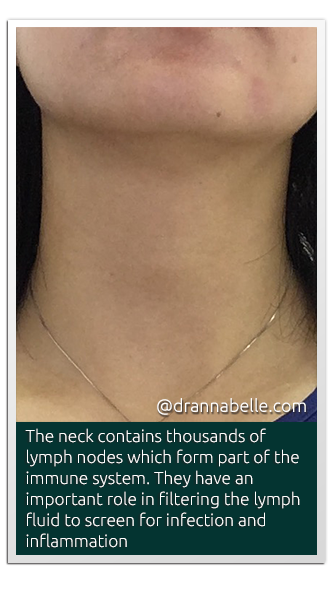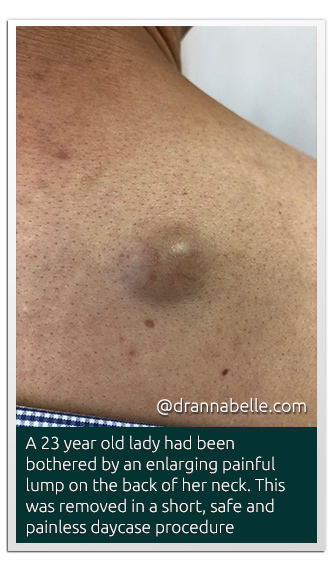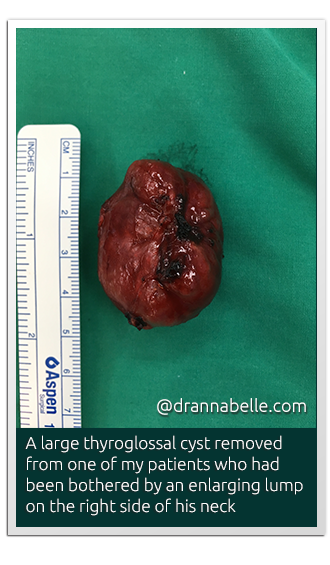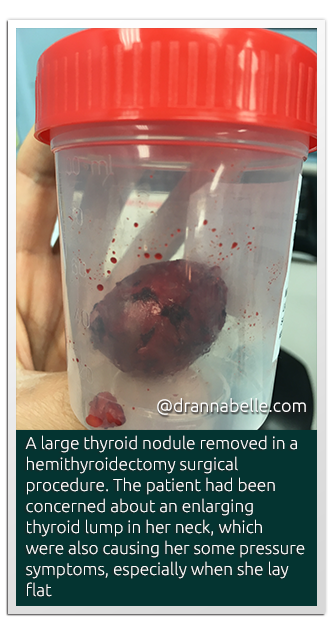Neck Lumps and Thyroid Problems
Neck Lumps
Lumps or swellings in the neck are quite common. Although the vast majority are benign, sometimes they can be a sign of a more serious underlying disease.
What are the causes of a neck lump?
1. Lymph nodes
The lymph nodes of the head and neck have an important role in draining the lymph fluid to screen for infection and inflammation. Lymph nodes most commonly swell up to become enlarged when there is infection e.g. after the flu (upper respiratory tract infection), also known as “reactive” lymph nodes. Any infection that affects the head and neck region e.g. an infected pimple, dental infections, ear infection, can lead to enlarged lymph nodes. Reactive lymph nodes may take a few weeks and sometimes even a few months to disappear completely. Sometimes, lymph nodes may become enlarged due to underlying cancer and will need further testing to be done.

2. Skin conditions
Another common reason for a neck lump is related to skin conditions such as infected sebaceous cysts. These cysts form in the skin when normal skin glands which produce sebum (natural oil), become blocked and swell up.

3. Thyroid lumps
The thyroid gland is an important gland which controls our general health, growth and well-being by secreting thyroid hormones. It is a butterfly-shaped gland which sits in front of the neck and airway.
Although most thyroid lumps or nodules are usually benign, there is approximately 10-15% risk that thyroid nodules may become malignant (turn cancerous).
Other problems with the thyroid may result if the thyroid gland either goes into overdrive to produce too much thyroid hormone, or does not secrete enough thyroid hormone.
3 Key investigations for a thyroid lump:
- Ultrasound scan of the thyroid gland
- Thyroid function blood tests to check hormone and antibody levels
- Fine Needle Aspiration (FNA): This involves a tiny needle inserted into the thyroid lump to remove cells (microscopic soft tissue) for analysis, essentially a “mini-biopsy”.
4. Thyroglossal cyst
As the thyroid gland develops, it gradually moves down from the back of the tongue to the neck itself. Thyroglossal cysts form when there is remaining tissue left behind in the thyroid gland’s path of descent into the neck. They may become infected, continue to grow bigger or very rarely, may contain cancerous cells.

5. Saliva gland lumps
Saliva glands secrete saliva to help moisten and digest our food when we eat. The largest pair sit on each side of your face, just in front of the ears (the parotid glands). Another pair of saliva glands (the submandibular glands) lie at the upper part of the neck, just below the jawbone. There are also thousands of minor salivary glands all over the lining of your mouth and throat.
Lumps in the saliva glands may be benign or malignant (cancerous). Imaging
in the form of an ultrasound or CT scan may be helpful in determining the
nature of the lump. Sometimes, a fine needle aspiration (FNA) may be
performed to obtain a tissue sample from the lump before the decision to
undergo surgery is made.
Thyroid Lumps and Thyroid Disease
Thyroid conditions are quite common and most thyroid lumps are usually benign (non-cancerous).
However, there is a 10-15% risk of thyroid lumps becoming malignant (cancerous), so thyroid lumps should be investigated with an ultrasound scan and often, an ultrasound-guided fine needle biopsy is performed to help determine the nature of the thyroid lump. Thyroid blood tests are also arranged as part of the workup as some thyroid lumps may be associated with an overproduction or underproduction of thyroid hormone, an extremely important hormone which regulates our growth and well-being.
Under-production of thyroid hormone may mean needing to take regular daily thyroid hormone supplements whilst over-production of thyroid hormone may require special medication to stabilise the high thyroid hormone levels. This is particularly important if someone decides to undergo surgery as uncontrolled high levels of thyroid hormone in the blood may trigger a life-threatening emergency health crisis known as a “thyroid storm”.
Although many thyroid lumps may be conservatively managed by carefully monitoring them with regular ultrasound scans, some lumps may need to be surgically removed in the form of a hemi- or total thyroidectomy procedure. Treatment of thyroid lumps depends on several factors , such as the size and nature of lump, the patient’s gender and age. Some thyroid lumps may also be the source of too much thyroid hormone production so surgery may be performed to remove these “toxic” thyroid nodules.
If thyroid surgery is indicated, then the thyroid lump is usually removed together with that half of the thyroid gland: this procedure is called a hemi-thyroidectomy. Although this is usually a straightforward procedure, the main risks are potentially bleeding and damage to the nerve which controls that half of the voicebox, which could lead to a weaker, raspier voice. A small suction drain is inserted at the end of surgery to allow drainage of any fluid/blood to prevent a haematoma (blood clot) forming inside the neck.







